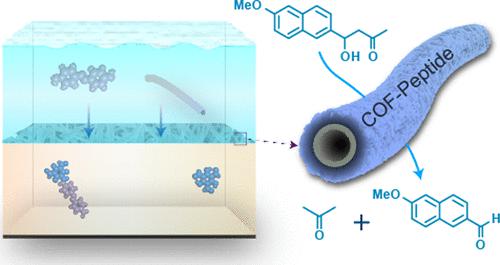当前位置:
X-MOL 学术
›
J. Am. Chem. Soc.
›
论文详情
Our official English website, www.x-mol.net, welcomes your feedback! (Note: you will need to create a separate account there.)
Covalent Organic Framework Cladding on Peptide-Amphiphile-Based Biomimetic Catalysts
Journal of the American Chemical Society ( IF 15.0 ) Pub Date : 2023-06-02 , DOI: 10.1021/jacs.3c03562 Ashok Kumar Mahato 1, 2 , Sumit Pal 1, 2 , Kaushik Dey 1, 2 , Antara Reja 1, 2 , Satyadip Paul 1, 2 , Ankita Shelke 3 , Thalasseril G Ajithkumar 3 , Dibyendu Das 1, 2 , Rahul Banerjee 1, 2
Journal of the American Chemical Society ( IF 15.0 ) Pub Date : 2023-06-02 , DOI: 10.1021/jacs.3c03562 Ashok Kumar Mahato 1, 2 , Sumit Pal 1, 2 , Kaushik Dey 1, 2 , Antara Reja 1, 2 , Satyadip Paul 1, 2 , Ankita Shelke 3 , Thalasseril G Ajithkumar 3 , Dibyendu Das 1, 2 , Rahul Banerjee 1, 2
Affiliation

|
Peptide-based biomimetic catalysts are promising materials for efficient catalytic activity in various biochemical transformations. However, their lack of operational stability and fragile nature in non-aqueous media limit their practical applications. In this study, we have developed a cladding technique to stabilize biomimetic catalysts within porous covalent organic framework (COF) scaffolds. This methodology allows for the homogeneous distribution of peptide nanotubes inside the COF (TpAzo and TpDPP) backbone, creating strong noncovalent interactions that prevent leaching. We synthesized two different peptide-amphiphiles, C10FFVK and C10FFVR, with lysine (K) and arginine (R) at the C-termini, respectively, which formed nanotubular morphologies. The C10FFVK peptide-amphiphile nanotubes exhibit enzyme-like behavior and efficiently catalyze C–C bond cleavage in a buffer medium (pH 7.5). We produced nanotubular structures of TpAzo–C10FFVK and TpDPP–C10FFVK through COF cladding by using interfacial crystallization (IC). The peptide nanotubes encased in the COF catalyze C–C bond cleavage in a buffer medium as well as in different organic solvents (such as acetonitrile, acetone, and dichloromethane). The TpAzo–C10FFVK catalyst, being heterogeneous, is easily recoverable, enabling the reaction to be performed for multiple cycles. Additionally, the synthesis of TpAzo–C10FFVK thin films facilitates catalysis in flow. As control, we synthesized another peptide-amphiphile, C10FFVR, which also forms tubular assemblies. By depositing TpAzo COF crystallites on C10FFVR nanotubes through IC, we produced TpAzo–C10FFVR nanotubular structures that expectedly did not show catalysis, suggesting the critical role of the lysines in the TpAzo–C10FFVK.
中文翻译:

基于肽两亲化合物的仿生催化剂上的共价有机骨架包覆
基于肽的仿生催化剂是在各种生化转化中具有高效催化活性的有前途的材料。然而,它们在非水介质中缺乏操作稳定性和易碎性限制了它们的实际应用。在这项研究中,我们开发了一种包覆技术来稳定多孔共价有机骨架 (COF) 支架内的仿生催化剂。这种方法允许肽纳米管在 COF(TpAzo 和 TpDPP)主链内均匀分布,产生强的非共价相互作用,防止浸出。我们合成了两种不同的肽两亲物,C 10 FFVK 和 C 10 FFVR,分别在 C 末端具有赖氨酸 (K) 和精氨酸 (R),从而形成纳米管形态。C 10FFVK 肽-两亲物纳米管表现出类似酶的行为,并在缓冲介质 (pH 7.5) 中有效催化 C-C 键断裂。我们使用界面结晶 (IC) 通过 COF 包覆生产了 TpAzo–C 10 FFVK 和 TpDPP–C 10 FFVK 的纳米管结构。包裹在 COF 中的肽纳米管在缓冲介质以及不同的有机溶剂(如乙腈、丙酮和二氯甲烷)中催化 C-C 键断裂。TpAzo–C 10 FFVK 催化剂是多相的,易于回收,使反应能够进行多个循环。此外,TpAzo–C 10 FFVK 薄膜的合成促进了流动中的催化作用。作为对照,我们合成了另一种肽两亲物,C 10FFVR,它也形成管状组件。通过 IC 在 C 10 FFVR 纳米管上沉积 TpAzo COF 微晶,我们生产了 TpAzo–C 10 FFVR 纳米管结构,预计不会显示催化作用,表明赖氨酸在 TpAzo–C 10 FFVK 中的关键作用。
更新日期:2023-06-02
中文翻译:

基于肽两亲化合物的仿生催化剂上的共价有机骨架包覆
基于肽的仿生催化剂是在各种生化转化中具有高效催化活性的有前途的材料。然而,它们在非水介质中缺乏操作稳定性和易碎性限制了它们的实际应用。在这项研究中,我们开发了一种包覆技术来稳定多孔共价有机骨架 (COF) 支架内的仿生催化剂。这种方法允许肽纳米管在 COF(TpAzo 和 TpDPP)主链内均匀分布,产生强的非共价相互作用,防止浸出。我们合成了两种不同的肽两亲物,C 10 FFVK 和 C 10 FFVR,分别在 C 末端具有赖氨酸 (K) 和精氨酸 (R),从而形成纳米管形态。C 10FFVK 肽-两亲物纳米管表现出类似酶的行为,并在缓冲介质 (pH 7.5) 中有效催化 C-C 键断裂。我们使用界面结晶 (IC) 通过 COF 包覆生产了 TpAzo–C 10 FFVK 和 TpDPP–C 10 FFVK 的纳米管结构。包裹在 COF 中的肽纳米管在缓冲介质以及不同的有机溶剂(如乙腈、丙酮和二氯甲烷)中催化 C-C 键断裂。TpAzo–C 10 FFVK 催化剂是多相的,易于回收,使反应能够进行多个循环。此外,TpAzo–C 10 FFVK 薄膜的合成促进了流动中的催化作用。作为对照,我们合成了另一种肽两亲物,C 10FFVR,它也形成管状组件。通过 IC 在 C 10 FFVR 纳米管上沉积 TpAzo COF 微晶,我们生产了 TpAzo–C 10 FFVR 纳米管结构,预计不会显示催化作用,表明赖氨酸在 TpAzo–C 10 FFVK 中的关键作用。



























 京公网安备 11010802027423号
京公网安备 11010802027423号